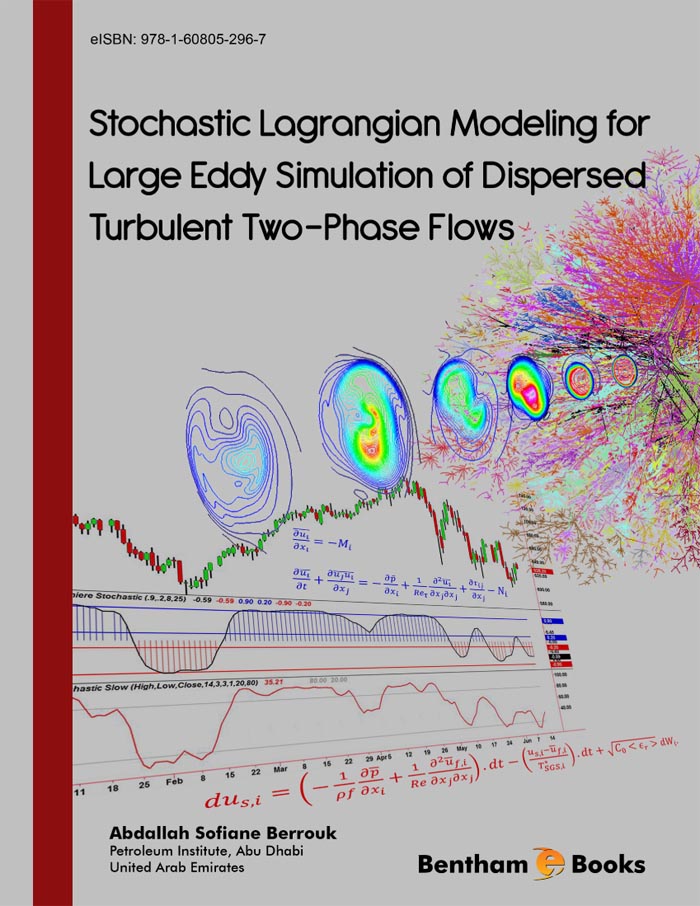This e-Book presents an introduction to the numerical simulation of turbulent dilute two-phase flows using the very promising mesoscale approach namely; Large Eddy simulation (LES). The text details the use of the stochastic diffusion process in conjunction with LES approach to simulate industrial applications dealing with very small, turbulence-responsive particles convected by high-Reynolds, non-homogeneous and anisotropic flows. This novel approach has been proven to increase the accuracy of two-phase LES while keeping the computing cost at an affordable level.
The goal is to present a text that engineering researchers can read and understand and from which they can attack a variety of industrial problems. It serves only as a preliminary exposure to the readers who are interested in developing the subject at more advanced level. In order to achieve the dual objectives of understanding and simplicity, lengthy mathematical analysis was avoided and emphasis was placed on detailed applications.
The material included in this book is organized to facilitate the understanding of the numerical approach in the context of dilute gas-particle systems. The context in which the stochastic LES-particle is developed is explained in Chapter 1. In Chapters 2 and 3, the most important aspects of LES of single- and two-phase turbulent flows are covered, respectively. A separate chapter (Chapter 4) details the stochastic model developed to track small inertial particles transported by the LES-predicted turbulent flows. For that purpose, the simplest mathematical approach is used, consistent with technical vigor. In the subsequent three chapters (Chapters 5, 6 and 7), three important flow applications are presented in almost every details. The aim is to show the promising potential which the stochastic LES-particle approach has in tackling dispersed industrial flows. Also, to use the stochastic LES-particle approach to explain many of the experimental findings on inertial particle transport by turbulent flows.
The e-Book is written with the necessary dose of both the physics and the numerics needed to quickly understand such a topic, and use it to tackle important industrial applications. It is brief and easy, yet to-the-point, description of an important topic written in a style and language often preferred by young graduate students and young researchers. It may be used in several ways at various stages of particulate flow modeling. It may help postgraduates and researchers interested in applying tractable yet powerful numerical tools to solve problems involving multiphase flows. Researchers in chemical, mechanical, petroleum and environmental engineering are the primary targets. Also, R&D people working for industries, such as the chemical and petrochemical industries should find this book very helpful in their continuing endeavor to adopt shorter design cycles through increased reliance on numerical prediction. Conventional models for turbulent dispersed flows do not appear capable of meeting the growing needs of these industries in this regard and the physical testing is prohibitive.
This e-Book is essentially the outcome of my last five years of association with this subject. I have received great deal of help from numerous persons over these years in formulating and revising my views on this numerical approach for particulate turbulent flows. I am particularly indebted to my teacher and mentor, Professor D. Laurence, who has been one of the leading practitioners of large eddy simulation technique for three decades at both Electricite de France and the University of Manchester. There are no adequate words to express his contributions to my understanding of the subject. I was fortunate to have an opportunity to work with Professor J.J. Riley at University of Washington-Seattle. Without his support and critics, it would not have been possible to develop the stochastic model. I would like to acknowledge the support provided by Emeritus Professor M.W. Reeks of University of Newcastle, Emeritus Professor D.E. Stock of Washington State University, and Professor Krishnanswamy Nandakumar of Louisiana State University. I would like to thank Dr. Alexander Douce of Electricite de France, Dr. Andy Lowe of the University of Manchester, and Dr. Chunliang Wu of Guangdong Ocean University, China for sharing knowledge about the subject.
I am grateful to one of my brilliant students, Mohamed Abu-Taqiya, at the Petroleum Institute- Abu Dhabi who helped me collect the required information, edit and proofread the book. Any remaining errors or shortcomings are the responsibility of the author. Finally, I wish to thank my wife, Karima, for her patience, understanding and enthusiastic support, which carried me through this long and arduous writing process.
Abdallah Sofiane Berrouk
Chemical Engineering Department
Petroleum Institute
UAE
Abu Dhabi, January 2011

